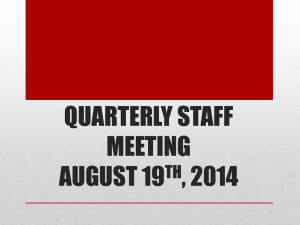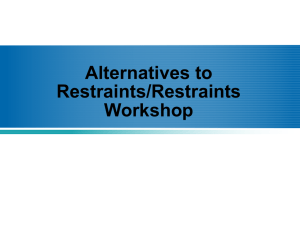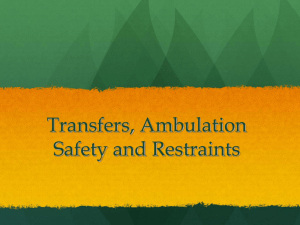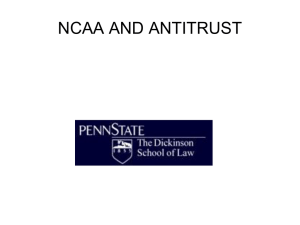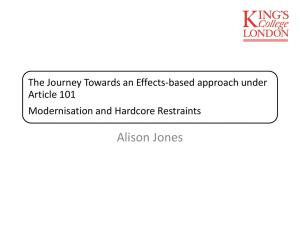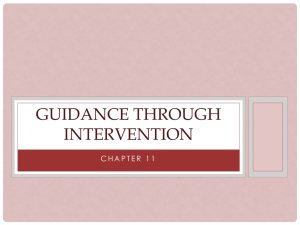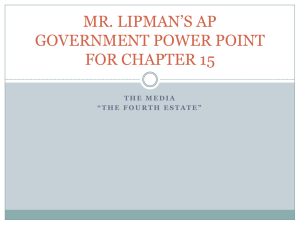powerpoint slides
advertisement
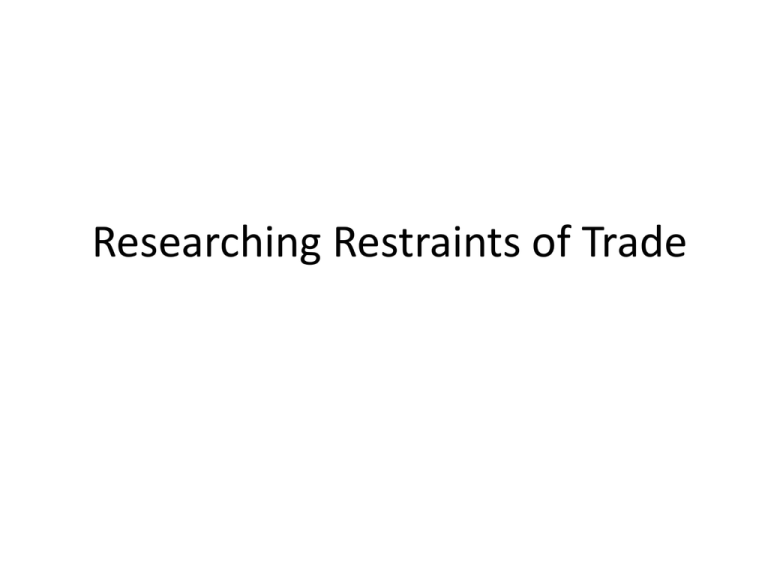
Researching Restraints of Trade Restraint Restraints You understand and acknowledge that: a.you occupy a responsible position with Emeco; b.Emeco's relationship with its Clients are critical to the business; i.it is in Emeco's legitimate business interests to promote the preservation of its relationship with its Clients; a.it is in Emeco's legitimate business interests to protect the use by you or other of Confidential Information to its detriment; b.the restraints in this clause are reasonable and necessary to protect the legitimate business interests of Emeco in the preservation of its client relations the good will of its business and its Confidential Information. You agree not to engage (either directly or indirectly) in each or any of the activities specified in sub-clause (a)(1) - (4), within the areas and for the periods after the Termination Date as specified in sub-clause (b)(1) , without the prior written consent of Emeco: a) 1. provide or take part in the provision of consultancy services or otherwise perform work for or provide products or services to a business competitive with the business of Emeco [the Competitor Restraint]; 1.canvass, solicit or entice away or attempt to canvass, solicit or entice away the business of any Client [the Non-Solicitation Restraint]; 2.perform work for or provide products or services to any Client, except for where the dealings do not, or work does not, involve or relate to the products or services provided by Emeco [the Client Restraint]; 3.induce or attempt to induce any Client or any Person who is at the Termination Date an employee, agent, director, officer, partner, consultant, contractor or adviser of Emeco, to terminate or to not renew any contract of any sort which they may have with Emeco or to disclose any information in relation to the business or affairs of Emeco which has been obtained by them through their dealings with Emeco [the Inducement Restraint]. b) 1. In Western Australia for a period of 6 months, unless that period is held invalid for any reason by a court of competent jurisdiction, in which case, 3 months. Grant • • • • • • • • • • • • • • • • • DP0987637 Mr C Fenwick; Dr W van Caenegem; Prof CJ Arup; Dr CM Dent 'Nothing Can Be Created Out of Nothing': Workers, Their Know-How and the Employment Relationships that Support Them Approved Project Title 2009 : 2010 : 2011 : $ 90,000 $ 70,000 $ 50,000 The University of Melbourne The importance of innovation, either in the form of intellectual property or know-how, to the Australian economy cannot be over-stated. Unlike statutory intellectual property schemes, worker-created know-how is both 'incentivised' and controlled through the contractual provisions of the worker-employer relationship. This project, through its empirical focus, will explore if (and how) the law, as it relates to know-how, promotes innovation in the workplace. Through the development of guidelines for best practice and reform proposals to fill gaps in the law, this research will increase the potential for innovation in all worker-employer relationships which will, in turn, maximise this country's creative and technological capability. WHAT/WHOSE KNOWLEDGE? RESTRAINTS OF TRADE AND CONCEPTS OF KNOWLEDGE CHRISTOPHER ARUP* [Where are the courts currently drawing the lines, between the employer’s confidential information and connections with customers and the employee’s own explicit, tacit and personal knowledge, when they are asked to enforce restraints of trade? As part of the new social economy, we see a temporal contradiction — between the desire for immediate control and the value of sharing knowledge. This article examines the concepts of knowledge the courts are using to distinguish claims and to fashion remedies. The assessment supports the primacy of this approach and recommends ways the courts should continue to refine and administer their concepts.] Contents • • • • • • Research inquiry Decision making principles Concepts of knowledge Explicit, tacit and personal knowledge Production and customer knowledge Production knowledge in the courts: – – – – The employer’s explicit knowledge The employee’s explicit, tacit and personal knowledge The reach of the restraint Remedies and the role of time • Customer knowledge in the courts: • Conclusions Method • The study proceeds first by clearing the ground of other principles by which the courts might decide the enforceability of restraints. It then enlists concepts of knowledge from the social sciences to act as measures of the discrimination with which the courts distinguish between the parties’ claims to capital or labour. • The research investigates how the courts are discriminating by reading the decisions in the New South Wales and Victorian jurisdictions in the last decade. These decisions number over 100 and the rate appears to be increasing. Cases • A list of cases is appended. The decisions were located on the AustLII database, with some guidance from the LexisNexis ‘CaseBase’ and Thomson Legal Online ‘FirstPoint’ case citator services. The decisions are limited to postemployment restraints, leaving aside exclusive services contracts, or restraints on partners and other commercial parties. My thanks to Michael Cole for his painstaking research assistance. There can of course be a problem with excessive reliance on decided cases. The question of validity of a covenant in restraint of trade (including, in this, a covenant against solicitation of the covenantee’s customers or clients) is not really a question of law. Decided cases state the relevant principles, and may prove useful, indeed valuable, guidance as to their application in particular factual circumstances. But the validity of a covenant in restraint of trade is to be assessed having regard to the terms of the particular covenant and the facts of the particular case. McDougall J, Stacks/Taree Pty Ltd v Marshall (No 2) [2010] NSWSC 77 at [54] Recommendations - When enforcing a restraint on work with competitors, the courts should insist that the employer specify confidential information with precision, even if that information could be said to have merged in the employee’s head with the employee’s explicit, tacit and personal knowledge; - in deciding whether information is confidential, and for how long it remains so, the courts should place emphasis on the utility of the information and the ease with which it can be externally acquired or duplicated; - in deciding whether to protect the employer’s connection to customers, the courts should first seek evidence of confidential information about customer service, before moving to restrain the employee’s personal knowledge of and influence over customers; - the courts should be very reluctant to find that the employee’s personal knowledge of and influence over particular customers is ‘in truth’ attributable to the employer; and - the courts should firmly favour restraints on activities that fall short of non-competition and restraints that run in time strictly according to the utility of the employer’s information RESTRAINTS OF TRADE: THE LEGAL PRACTICE C. Arup*, C. Dent**, J. Howe*** and W. van Caenegem**** In this article, following the introduction, we identify the uncertainty in the legal principles that contributes to the influence of the legal practice. In the third section, the legal proceedings are examined and some recent cited decisions are mentioned. The fourth section characterises the nature of the parties’ decision making about litigation and locates the burden of uncertainty. The final section nominates some reforms that are aimed at reducing the burden – particularly as experienced by employees who are subject to the restraints. Contents • Research inquiry • Legal uncertainty and the role of legal practice • Legal proceedings: commencing proceedings, apply for injunctions, settlements, trial and disposition • The variable of the court • The burden of uncertainty • Employee and employer resources • Finings: Hard bargaining and inside knowledge • Reforms Method • To explore the role of these variables, our research supplemented the cited decisions, texts and papers with a set of interviews with legal practitioners. • We located twenty-four practitioners through a variety of sources, including professional contacts, participation in court cases, profiles at law firm websites and learned publications. We found that most (two-thirds) of those practitioners were solicitors. They were employment law specialists in the big national commercial law firms, the boutique workplace practices and the traditional labour law firms. Some acted for employers, some for employees, and some had a mixed clientele. We also interviewed several barristers - and judges from two state supreme courts. • We conducted interviews with practitioners in the capital cities of all mainland States (though the majority were located in Brisbane, Melbourne and Sydney). The interviews, carried out in 2010, 2011 and 2012, adopted a semi-structured format using a common set of questions and following leads the interviewees gave us. Each ran over an hour. • • • • • • • • • • • • • • • • • The Honourable Justice Supreme Court of Victoria 15 August 2012 • • • The Honourable T F Bathurst Chief Justice Supreme Court of NSW GPO Box 3 Sydney NSW 2001 • • Dear Chief Justice Academic Research Restraint of Trade Proceedings • We write to request for permission to research the Court’s data regarding proceedings filed to enforce restraints of trade. • We have been granted Australian Research Council funds to research the relationships that support the development and use of employee know-how. We are focusing our research on the role of restraints of trade in employment contracts. • Our research has involved interviews with senior practitioners in Sydney, Melbourne and Brisbane. The interviews indicate that most disputes are settled, even after proceedings are issued. Some proceedings are by way of an application for an interim order and very few go to trial. We are interested in the statistics regarding this course of events. The published court decisions provide only a limited picture. • We can see from the Annual Reviews that the Court collects data on filings by jurisdiction (we believe most restraint proceedings would fall into the Expedition List of the Equity Jurisdiction) and also by manner of disposition. We were interested to know whether the restraint of trade cases can be extracted from this data. • If that is not the case, our request would be for access to the filings in the Court’s registry so that we might ascertain the rate and progress of restraint proceedings. Such access might also provide information about the components of the proceedings, for example whether they relate to claims of confidential information or customer connection. • We appreciate that this request is an imposition on the Court and on the Registry in particular. If access can be granted, and the task is not too large, we shall employ a legal researcher to conduct the searches and compile the figures. We wish to stress that we are all experienced researchers with an appreciation of the sensitivity of case particulars. We are interested only in the overall pattern of proceedings in the Court, not in the particulars of an individual case. We have received ethics approval for our research from the University of Melbourne. • We ask that you consider the request. We are ready to provide more information about our research and of course to agree to protocols for this access to the records. Professor Arup is available to attend the Court to discuss this further. Would it be possible for him to meet with someone from the Court? Dear Justice Academic Research - Restraints of Trade We have been granted Australian Research Council funds to research the relationships that support the development and use of employee know-how. To make the best use of the resources, we are focusing our research on the role of restraints of trade in employment contracts. Our research includes the nature of the principles that govern the enforceability of restraints and the considerations applicable in each case. Our study takes us also to the practical experience of the prosecution and adjudication of the applications to enforce restraints. Our research has involved interviews with senior practitioners in Sydney, Melbourne, Brisbane and Perth. We were also very kindly granted an interview with Justice Brereton of the NSW Supreme Court. We would like to gain the insights of a member of the Victorian Court as the other main jurisdiction in this area. We have read the judgements delivered in the recent Victorian cases concerning restraints of trade. They are each decided by a different judge and we thought it best to approach the head of the Court’s commercial and equity division. Our request is to be granted an interview so we might ask you about the demands on the Court of hearing and deciding these cases, as well as any reflections you may have with respect to the operation of the law in this area. If the opportunity to speak with you is not available, we ask, in the alternative, whether you might be prepared to refer us to a fellow judge who would be close to this jurisdiction. We wish to stress that we are experienced researchers with an appreciation of the protocols that should be respected when conducting interviews with judicial decision-makers. We also note that our research has received clearance from the University of Melbourne Human Research Ethics Committee. We ask that you please consider our requests. We are ready to provide more information about our research and to agree to any protocols required by the Court for such an interview. This research forms part of a project funded by an Australian Research Council Discovery Grant DP0987637 from 2009-2011. We would like to thank the following people who assisted us, J. Bornstein, P. Brereton, G. Dann, C. Dean, T. Forno, E. Goodwin, S. Horneman-Wren, A. Jegathesan, J. Kelly, A. Lunn, J. Lunny, L. Mandie, A. Moses, A. Pagone, C. Power, P. Punch, V. Rogers, M. Saraceni, G. Smith, L. Smith and A. Stewart. These people generously gave their insights on the basis of the anonymisation of their responses. As a result, all quotes and comments will be attributed to a pseudonym. We have also been generously assisted by various academic colleagues, as well as the pioneers of empirical legal studies, which we feel represent such a valuable counterpart to formalist approaches. Reforms • Outlaw restraints • Limit restraints • - Legislative limits: limit length of restraint, require payment during restraint • - Judicial limits: make clear, conservative rulings, no modification to restraints – make the employer specify precisely • Procedural reforms • - Shift from the supreme courts to an employment tribunal • - Make it a no costs jurisdiction or control costs closely • - Interlocutory injunctions: require a stronger case of employers or withhold interlocutory relief in favour of trials and proof of damage References • C. Arup, What/Whose Knowledge: Restraints of Trade and Concepts of Knowledge, Melbourne University Law Review, 36, 369414, 2012. • • C. Arup, C. Dent, J. Howe and W. van Caenegem, Restraints of Trade: The Legal Practice, University of New South Wales Law Journal, 36(1), 2013.
